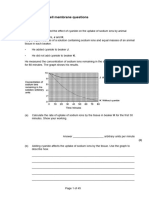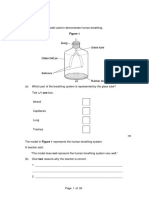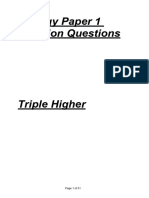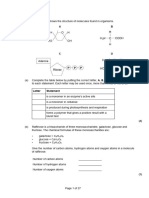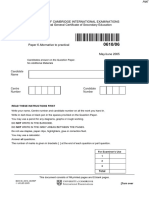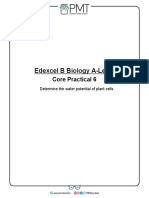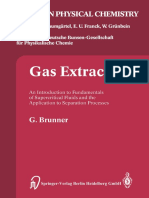Set 5 Bioenergetics Grades 4 6
Set 5 Bioenergetics Grades 4 6
Uploaded by
Abir OmarCopyright:
Available Formats
Set 5 Bioenergetics Grades 4 6
Set 5 Bioenergetics Grades 4 6
Uploaded by
Abir OmarOriginal Description:
Copyright
Available Formats
Share this document
Did you find this document useful?
Is this content inappropriate?
Copyright:
Available Formats
Set 5 Bioenergetics Grades 4 6
Set 5 Bioenergetics Grades 4 6
Uploaded by
Abir OmarCopyright:
Available Formats
(i) What is the name of the process which takes place in living cells in your body and which
1 releases energy from oxygen and glucose?
___________________________________________________________________
(1)
(ii) Name the two products of the process in part (i).
_______________________________ and _______________________________
(1)
(Total 2 marks)
The graph shows the concentration of carbon dioxide in the air in a greenhouse full of tomato
2 plants, measured over a period of 24 hours.
(a) Explain why the concentration of carbon dioxide in the air in the greenhouse increased
between X and Y.
___________________________________________________________________
___________________________________________________________________
___________________________________________________________________
___________________________________________________________________
(2)
Rossett School Page 1 of 17
(b) Explain why the concentration of carbon dioxide in the air in the greenhouse decreased
between Y and Z.
___________________________________________________________________
___________________________________________________________________
___________________________________________________________________
___________________________________________________________________
(2)
(Total 4 marks)
(a) Respiration is a process which takes place in living cells. What is the purpose of
3 respiration?
___________________________________________________________________
___________________________________________________________________
(1)
(b) (i) Balance the equation for the process of respiration when oxygen is available.
C6H12O6 + O2 → CO2 + H 2O
(1)
(ii) What is the name of the substance in the equation with the formula C6H12O6?
______________________________________________________________
(1)
(c) Oxygen is absorbed through the alveoli in the lungs.
(i) How are the alveoli adapted for this function?
______________________________________________________________
______________________________________________________________
______________________________________________________________
(2)
(ii) Name the gas which is excreted through the alveoli.
______________________________________________________________
(1)
(d) (i) What is the name of the process of respiration when oxygen is not available?
______________________________________________________________
(1)
Rossett School Page 2 of 17
(ii) Describe the process of respiration which takes place in human beings when oxygen
is not available and give an effect.
______________________________________________________________
______________________________________________________________
______________________________________________________________
______________________________________________________________
______________________________________________________________
______________________________________________________________
(3)
(Total 10 marks)
In an investigation four groups of athletes were studied. The maximum rate of oxygen
4 consumption for each athlete was measured and the mean for each group was calculated. The
athletes then ran 10 mile races and the mean of the best times was calculated for each group.
The results are shown in the table below.
(i) What is the relationship between maximum rate of oxygen consumption and time for a 10
mile race?
___________________________________________________________________
___________________________________________________________________
(1)
Rossett School Page 3 of 17
(ii) Suggest an explanation for this relationship.
___________________________________________________________________
___________________________________________________________________
___________________________________________________________________
___________________________________________________________________
___________________________________________________________________
___________________________________________________________________
(3)
(Total 4 marks)
(a) Balance the following equation for photosynthesis.
5
______ CO2 + ______ H2O → C6HI2O6 + ______ O2
(1)
(b) Give two conditions necessary for photosynthesis apart from a suitable temperature range
and the availability of water and carbon dioxide.
1. _________________________________________________________________
2. _________________________________________________________________
(2)
(a) Plants have leaves which contain guard cells and palisade cells. Explain how each of these
kinds of cell assists photosynthesis.
Guard cells _________________________________________________________
___________________________________________________________________
___________________________________________________________________
___________________________________________________________________
(2)
Palisade cells _______________________________________________________
___________________________________________________________________
___________________________________________________________________
___________________________________________________________________
(2)
Rossett School Page 4 of 17
(d) Glucose is a product of photosynthesis. Give three uses which green plants make of
glucose.
1. _________________________________________________________________
2. _________________________________________________________________
3. _________________________________________________________________
(3)
(Total 10 marks)
A plant with variegated (two-coloured) leaves was left in sunlight for several hours. Pieces of
6 one of its leaves were then detached (removed) and tested for sugar. The diagram below shows
the results.
Explain, as fully as you can, why the yellow region of the leaf had not produced sugar.
_______________________________________________________________________
_______________________________________________________________________
_______________________________________________________________________
_______________________________________________________________________
_______________________________________________________________________
_______________________________________________________________________
(Total 2 marks)
Rossett School Page 5 of 17
Fermentation of sugar by yeast produces carbon dioxide.
7
The graph shows the effect of temperature on the production of carbon dioxide by fermentation.
(a) By how much did the volume of carbon dioxide collected change when the temperature
was raised from 30°C to 40°C?
________________________________________ cm3
(1)
(b) Complete the sentences to explain the shape of the curve between X and Y.
Raising the temperature _________________ the speed of the reacting particles.
These particles collide more _________________ and more _________________ .
(3)
(Total 4 marks)
Green plants make food in their leaves.
8
(a) From where do the leaves get the energy that they need to make food?
___________________________________________________________________
(1)
Rossett School Page 6 of 17
(b) The graph shows the effect of temperature on the rate of photosynthesis.
(i) Between which temperatures is the rate of photosynthesis fastest?
_______________ and _______________ °C
(1)
(ii) Suggest why the rate of photosynthesis stays the same between these two
temperatures.
______________________________________________________________
______________________________________________________________
______________________________________________________________
______________________________________________________________
(2)
Rossett School Page 7 of 17
(iii) A greenhouse owner wants to grow lettuces as quickly and cheaply as possible in
winter.
At what temperature should he keep his greenhouse in order to grow the lettuces as
quickly and cheaply as possible?
_______________ °C
Explain your answer.
______________________________________________________________
______________________________________________________________
______________________________________________________________
______________________________________________________________
(3)
(Total 7 marks)
(a) Complete the equation for photosynthesis.
9
(2)
(b) The diagram below is printed in a plant care manual.
Use information from the diagram to answer the following questions.
(i) Name one type of plant which could live on the floor of a dense forest in the middle of
summer.
______________________________________________________________
(1)
Rossett School Page 8 of 17
(ii) Explain the reason for your answer to (i) above.
______________________________________________________________
______________________________________________________________
(1)
(iii) The drawing shows one type of plant with variegated leaves.
The manual says that these plants need direct sunlight.
Suggest and explain why this plant needs ‘some direct sunlight’ in order to develop
satisfactorily.
______________________________________________________________
______________________________________________________________
(2)
(iv) The drawing shows a cactus.
Rossett School Page 9 of 17
Suggest and explain why cacti can only develop satisfactorily if they receive
full sunlight.
______________________________________________________________
______________________________________________________________
______________________________________________________________
______________________________________________________________
(2)
(Total 8 marks)
A student breathed out into an empty breathing bag five times.
10
After breathing out five times the volume of air in the bag was measured.
The volume was 3000 cm3.
(a) Complete the following sentences.
The air the student breathed in would contain more ____________________ than the air
the student breathed out.
The air the student breathed out would contain more ___________________ than the air
the student breathed in.
(2)
Rossett School Page 10 of 17
(b) The student then did some exercise for two minutes. The volume breathed out in five
breaths was again measured. This time there was 9000 cm3 of air in the bag.
What does this tell you about the effect of exercise on breathing?
___________________________________________________________________
___________________________________________________________________
(1)
(c) (i) Name the chemical process that releases energy when it takes place in the cells of
the body.
______________________________________________________________
(1)
(ii) Name the substances produced by this process.
_____________________________ and _____________________________
(2)
(iii) Explain as fully as you can why this process has to take place more rapidly
during exercise.
______________________________________________________________
______________________________________________________________
______________________________________________________________
______________________________________________________________
(2)
(Total 8 marks)
Rossett School Page 11 of 17
Mark schemes
(i) (aerobic) respiration
1
do not credit anaerobic respiration
accept cellular respiration
1
(ii) carbon dioxide and water (vapour)
both required
do not credit heat
1
[2]
(a) respiration
2
reject start respiring / respire only at night
1
no photosynthesis because no light
1
(b) photosynthesis rate greater than respiration rate
1
reject no respiration / photosynthesis only
photosynthesis since light
1
[4]
(a) to transfer / provide / give release energy
3
or production of ATP / adenosine triphosphate (molecules)
accept to give heat
1
(b) (i) C6H12O6 + 6O2 → 6CO2 + 6H2O
accept any other
n : 6n : 6n : 6n ratio
do not credit if any other changes have been made
1
(ii) glucose
do not credit sugar / sucrose
1
Rossett School Page 12 of 17
(c) (i) any two from
large surface
thin (surface)
moist (surface)
(with a good) blood supply
2
(ii) carbon dioxide
accept water vapour
do not credit just water
1
(d) (i) anaerobic (respiration)
1
(ii) any three from
in mitochondria
glucose decomposes / breaks down / reacts
or glucose → lactic acid for (2) marks
to give lactic acid
or breathing hard
or lactic acid → CO2 + water
causing pain
(leaving an) oxygen debt
(quick) source of energy
(but) less efficient than aerobic respiration
accept less efficient than with oxygen
3
[10]
(i) the higher the rate of oxygen consumption, the shorter the
4 time taken to complete
for 1 mark
1
(ii) the faster oxygen is taken into the blood,
the faster energy can be released in the muscles,
and the faster the athlete can run
for 1 mark each
3
[4]
Rossett School Page 13 of 17
(a) 666
5
all required
accept a ’6n 6 n n 6n’ version of the balanced equation provided it
is correct in every detail
1
(b) any two of
• (presence of) chlorophyll or (amount of) chloroplasts
accept green leaves (or other green parts)
• (sufficient) light (intensity)
• (light) of a suitable wavelength
any light other than green light
do not credit Sun’s energy or sunshine or Sun
2
(c) guard cells
any two of
* control by osmosis
* the movement of gases
accept movement of carbon dioxide or oxygen or water vapour
beware movement of CO2 out
accept a diagram or description
* through the stoma
2
palisade cells
any two of
* near the upper surface
* contain (a great) many or more chloroplasts
* (so) contain the most chlorophyll
2
Rossett School Page 14 of 17
(d) any three of
* for respiration
* conversion to (insoluble) starch
or to food store or to (other)carbohydrates
* (conversion to) sucrose or to food store or to (other) carbohydrates
or polysaccharides
do not credit just to grow or live
or survive
accept conversion to food store
or to (other) carbohydrates once only
* (conversion to) lipids or fats or oils
* (conversion to) amino acids or (plant) proteins or auxins or (plant) hormones or enzymes
3
[10]
Does not contain chlorophyll which is needed to absorb light or energy
6
each for 1 mark
[2]
(a) 11
7
accept 10.5 – 11.5
1
(b) ideas of
increase / rises
1
frequently / often
1
energetically / violently
1
[4]
(a) Sun / sunlight / light
8
for 1 mark
1
(b) (i) 21.5 – 22 and 27 – 27.5
for 1 mark
1
Rossett School Page 15 of 17
(ii) ideas of limiting factor / shortage of
e.g. light / carbon dioxide / water /chlorophyll
each for 1 mark
(allow 1 for ‘maximum’ rate of enzyme activity if
no reference to limiting factors)
(ignore reference to dematuring)
2
(iii) 21.5 – 22° C
(allow first figure from answer to (i) so that no ‘double-penalty’ but
not below 20)
maximum rate of photosynthesis
(can relate to any number on ‘flat’)
most economical heating (must relate to left end of ‘flat’
each for 1 mark
3
[7]
(a) carbon dioxide
9 oxygen
2
(b) (i) e.g. rubber plant/fern
1
(ii) because can tolerate low light levels
1
(iii) yellow parts of leaf do not contain chlorophyll therefore more light
needed for photosynthesis
2
(iv) no leaves/only have stem only have small area which can
photosynthesise
2
[8]
(a) oxygen,
10 carbon dioxide or water (vapour)
for 1 mark each
2
(b) idea of more air per breath/deeper breaths
for 1 mark
1
Rossett School Page 16 of 17
(c) (i) respiration
for 1 mark
1
(ii) carbon dioxide,
water
for 1 mark each
2
(iii) more energy required,
for increased muscular activity
for 1 mark each
2
[8]
Rossett School Page 17 of 17
You might also like
- Respiration I QuestionsDocument79 pagesRespiration I QuestionsAayma MunirNo ratings yet
- Section A Answer ALL Question. Write Your Answers in The Spaces Provided in This BookletDocument8 pagesSection A Answer ALL Question. Write Your Answers in The Spaces Provided in This BookletJoy BoehmerNo ratings yet
- 5-10 - Grasshopper - Dissection AsDocument7 pages5-10 - Grasshopper - Dissection AsAbir OmarNo ratings yet
- Human Phys Part1 Digestheartimmune Questions AnswersDocument7 pagesHuman Phys Part1 Digestheartimmune Questions AnswersAbir OmarNo ratings yet
- Biology Mock Paper 02 - CorrectedDocument13 pagesBiology Mock Paper 02 - CorrectedNicketa AndersonNo ratings yet
- Organisation Foundation HigherDocument135 pagesOrganisation Foundation HigherSơnSơnNo ratings yet
- 4.1b Cell Biology Foundation HigherDocument70 pages4.1b Cell Biology Foundation Higherpzulu6774No ratings yet
- Set 1 Bioenergetics Grades 7 9Document22 pagesSet 1 Bioenergetics Grades 7 9Rabia RafiqueNo ratings yet
- A01 Short Answer QuestionsDocument21 pagesA01 Short Answer Questionsmsuria06No ratings yet
- Gasexchange Part 2Document66 pagesGasexchange Part 2/ “Nu” /No ratings yet
- 4.1 Photosynthesis QPDocument35 pages4.1 Photosynthesis QPZaynab Ameenah KhanNo ratings yet
- Year 11 Biology TIME: 2 HoursDocument12 pagesYear 11 Biology TIME: 2 HoursAdrianHedleyNo ratings yet
- Gas Exchange Part 2Document66 pagesGas Exchange Part 2abedalzarif21No ratings yet
- Energy and Ecosystems Part 2Document16 pagesEnergy and Ecosystems Part 2dfq67gtkqs100% (1)
- Set 3 Cell Biology Grades 7 9Document17 pagesSet 3 Cell Biology Grades 7 9Abir OmarNo ratings yet
- Respiration & Gas Exchange Theory QPDocument44 pagesRespiration & Gas Exchange Theory QPVivehaNo ratings yet
- 4.2 Respiration QPDocument26 pages4.2 Respiration QPmelonpanbearNo ratings yet
- 2.3 Transport Across Cell Membranes 1 E28093 Questions 1Document36 pages2.3 Transport Across Cell Membranes 1 E28093 Questions 1craisha25No ratings yet
- Formative Practice Chapter 2 (BI)Document8 pagesFormative Practice Chapter 2 (BI)suraya nazaNo ratings yet
- Membranes L4 MSDocument19 pagesMembranes L4 MSzaynabaziz52No ratings yet
- Set 2 Bioenergetics Grades 7 9Document20 pagesSet 2 Bioenergetics Grades 7 9tnishtalaNo ratings yet
- 5.6 The Rate and Extent of Chemical Change Test - Ques OnlyDocument16 pages5.6 The Rate and Extent of Chemical Change Test - Ques OnlyT WNo ratings yet
- Lipids PpqsDocument29 pagesLipids PpqsTerreshaNo ratings yet
- SDA End of Year 2023 (AutoRecovered)Document7 pagesSDA End of Year 2023 (AutoRecovered)Nothando PhologotswanaNo ratings yet
- 3.2.3 Transport Across Cell Revision Questions & AnswersDocument45 pages3.2.3 Transport Across Cell Revision Questions & Answersbushramedani40No ratings yet
- Biology 1Document11 pagesBiology 1namelessmsaniiNo ratings yet
- Critical Analysis QuestionsDocument54 pagesCritical Analysis Questionsalishariz329No ratings yet
- RespirationDocument99 pagesRespirationdfq67gtkqsNo ratings yet
- UnknownDocument57 pagesUnknownZara KhanNo ratings yet
- A01 Short Answer QuestionsDocument29 pagesA01 Short Answer Questionsmsuria06No ratings yet
- More Enzyme QuestionsDocument7 pagesMore Enzyme QuestionsAlNo ratings yet
- 4.2 Respiration QPDocument26 pages4.2 Respiration QPliufanjing07No ratings yet
- Triple HomeostasisDocument13 pagesTriple HomeostasisAbir OmarNo ratings yet
- Organisation QP 2Document31 pagesOrganisation QP 2lizablatchfordNo ratings yet
- Mon Omers and Polymers A LevelDocument57 pagesMon Omers and Polymers A Leveldfq67gtkqs100% (1)
- Paper 1 Revision - All - StudentDocument13 pagesPaper 1 Revision - All - Studentabillings2009No ratings yet
- A Level Biology Topic 1 AssessmentDocument15 pagesA Level Biology Topic 1 AssessmentgsapkaiteNo ratings yet
- 4.2 Respiration QPDocument28 pages4.2 Respiration QPspiceafro06No ratings yet
- 3.1.2 Carbohydrates EQDocument24 pages3.1.2 Carbohydrates EQteeb1826No ratings yet
- 1A RetestDocument10 pages1A Retest18mmyintNo ratings yet
- BiologyMock 2Document36 pagesBiologyMock 2backup14gNo ratings yet
- Extra Cells A and MSDocument29 pagesExtra Cells A and MSKhushi ShahNo ratings yet
- Crop 2030Document12 pagesCrop 2030Nqobile SingojwanaNo ratings yet
- Biology P1 PPQ HDocument51 pagesBiology P1 PPQ HJivon MathewNo ratings yet
- Biology P1 PPQ FDocument52 pagesBiology P1 PPQ FJivon MathewNo ratings yet
- AJ L7 Plant Transport Systems AQA Exam Qs Q1.: Cuticle Epidermis XylemDocument6 pagesAJ L7 Plant Transport Systems AQA Exam Qs Q1.: Cuticle Epidermis XylemIntelaNo ratings yet
- Section A Answer ALL Question. Write Your Answers in The Spaces Provided in This BookletDocument8 pagesSection A Answer ALL Question. Write Your Answers in The Spaces Provided in This BookletJoy BoehmerNo ratings yet
- 5.1.1 and 5.1.2Document10 pages5.1.1 and 5.1.2Aamina HussainNo ratings yet
- Nutrient CyclesDocument95 pagesNutrient Cyclesdfq67gtkqsNo ratings yet
- A-Level Biology Protein Exam QuestionsDocument27 pagesA-Level Biology Protein Exam Questionsfreyamartin90676100% (1)
- Bio - IIDocument12 pagesBio - IIMalitha PeirisNo ratings yet
- Thermal IIIqsDocument14 pagesThermal IIIqsjingcong liuNo ratings yet
- Thermal IIIDocument25 pagesThermal IIItroosterbandaNo ratings yet
- Biology Paper 1Document8 pagesBiology Paper 1paqurette3No ratings yet
- Biology (Form 4) - Test 1 (2019)Document12 pagesBiology (Form 4) - Test 1 (2019)Kordell leydNo ratings yet
- Bio Molecules Revion PPQsDocument15 pagesBio Molecules Revion PPQsali.a.226No ratings yet
- KO2 Transport in Cell HomeworkDocument11 pagesKO2 Transport in Cell Homeworkfahmidaakhi3313No ratings yet
- E2 Human Impact On The Environment Skill WS 2014, 2015, 2016Document18 pagesE2 Human Impact On The Environment Skill WS 2014, 2015, 2016Ching Man TamNo ratings yet
- WaterDocument16 pagesWaterdfq67gtkqsNo ratings yet
- CSEC Biology WORKSHEETDocument7 pagesCSEC Biology WORKSHEETAnderson Michelle100% (1)
- 5.2 RespirationDocument40 pages5.2 RespirationiyanublessingojoNo ratings yet
- Organic Chemistry Decoded: Master Orgo with Step-by-Step SolutionsFrom EverandOrganic Chemistry Decoded: Master Orgo with Step-by-Step SolutionsNo ratings yet
- Origami Gardens - 230612 - 133848Document6 pagesOrigami Gardens - 230612 - 133848Abir OmarNo ratings yet
- Mixed Questions Genetics1Document11 pagesMixed Questions Genetics1Abir OmarNo ratings yet
- June 2005 QP - Paper 6 CIE Biology IGCSE PDFDocument12 pagesJune 2005 QP - Paper 6 CIE Biology IGCSE PDFAbir OmarNo ratings yet
- Steven Fady Fayez Mehany: Youssef Ahmed Abdelmohsen YoussefDocument8 pagesSteven Fady Fayez Mehany: Youssef Ahmed Abdelmohsen YoussefAbir OmarNo ratings yet
- CP 08 - Tensile Strength of Plant FibresDocument2 pagesCP 08 - Tensile Strength of Plant FibresAbir OmarNo ratings yet
- CP 06 - Water Potential of Plant CellsDocument3 pagesCP 06 - Water Potential of Plant CellsAbir OmarNo ratings yet
- Specimen Paper 1 Mark Scheme PDFDocument2 pagesSpecimen Paper 1 Mark Scheme PDFAbir OmarNo ratings yet
- Set 1 Bioenergetics Grades 4 6Document19 pagesSet 1 Bioenergetics Grades 4 6Abir OmarNo ratings yet
- Detailed Notes - Topic 2 Cells and Control - Edexcel Biology GCSEDocument10 pagesDetailed Notes - Topic 2 Cells and Control - Edexcel Biology GCSEAbir OmarNo ratings yet
- Set 2 Cell Biology Grades 4 5 PDFDocument18 pagesSet 2 Cell Biology Grades 4 5 PDFAbir OmarNo ratings yet
- Set 3 Cell Biology Grades 7 9Document17 pagesSet 3 Cell Biology Grades 7 9Abir OmarNo ratings yet
- Specimen QP - Paper 3 OCR Biology (A) A-LevelDocument20 pagesSpecimen QP - Paper 3 OCR Biology (A) A-LevelAbir OmarNo ratings yet
- LabDocument4 pagesLabAbir OmarNo ratings yet
- Triple HomeostasisDocument13 pagesTriple HomeostasisAbir OmarNo ratings yet
- Set 1 Cell Biology Grades 1 3Document22 pagesSet 1 Cell Biology Grades 1 3Abir OmarNo ratings yet
- Ecology 7 9 4Document16 pagesEcology 7 9 4Abir OmarNo ratings yet
- Astm C473 03Document72 pagesAstm C473 03DhritiNo ratings yet
- Universality of The de Broglie-Einstein Velocity Equation: MC E MV PDocument2 pagesUniversality of The de Broglie-Einstein Velocity Equation: MC E MV PSlaven IvanovicNo ratings yet
- Wellboost 13967Document2 pagesWellboost 13967Bassem BalghouthiNo ratings yet
- Hydrometer Test: King Fahd University of Petroleum & Minerals CE 353 Soil Mechanics LaboratoryDocument9 pagesHydrometer Test: King Fahd University of Petroleum & Minerals CE 353 Soil Mechanics Laboratoryraja qammarNo ratings yet
- Identification Test For Ferrous SulphateDocument1 pageIdentification Test For Ferrous Sulphateshuklashashank863No ratings yet
- Flores, Markbrian Gravimetric AnalysisDocument3 pagesFlores, Markbrian Gravimetric AnalysisMark Brian FloresNo ratings yet
- UTP Student Industrial Project ReportDocument70 pagesUTP Student Industrial Project Reportrooparn2839192% (12)
- Certificate of AnalysisDocument7 pagesCertificate of Analysisdun_aromatixNo ratings yet
- 2352-0000-25RP-001 - Process Description Rev 0Document48 pages2352-0000-25RP-001 - Process Description Rev 0ashishrajoria13100% (1)
- Webquest Answers 1Document4 pagesWebquest Answers 1Carol RossNo ratings yet
- Forests 13 01070Document16 pagesForests 13 01070Emilia DuncaNo ratings yet
- NewmaRk inDocument2 pagesNewmaRk inShashi PrakashNo ratings yet
- ResearchDocument34 pagesResearchBenjamin TantiansuNo ratings yet
- SDBC Design CalculationsDocument33 pagesSDBC Design Calculationslkovijay100% (2)
- ASTM D 4239-2004 Standard Test Methods For Sulfur in The Analysis Sample of Coal and Coke Using High-Temperature Tube Furnace Combustion MethodsDocument8 pagesASTM D 4239-2004 Standard Test Methods For Sulfur in The Analysis Sample of Coal and Coke Using High-Temperature Tube Furnace Combustion MethodsAlison de Oliveira LarangeiraNo ratings yet
- Mfiv-II Mechanically Controlled Isolation Valve PsDocument2 pagesMfiv-II Mechanically Controlled Isolation Valve PsalainestorNo ratings yet
- Flemming, Wingender. 2001. Relevance of Microbial Extracellular Polymeric Substances (EPSs) - Part I Structural and Ecological AspectsDocument8 pagesFlemming, Wingender. 2001. Relevance of Microbial Extracellular Polymeric Substances (EPSs) - Part I Structural and Ecological AspectsAzb 711No ratings yet
- Magneto Hydrodynamic MHD Power GenerationDocument12 pagesMagneto Hydrodynamic MHD Power GenerationDinesh ChahalNo ratings yet
- Gas Extraction An Introduction To Fundamentals of Supercritical Fluids and The Application To Separation Processes by Prof. Dr.-Ing. Gerd Brunner (Auth.) PDFDocument396 pagesGas Extraction An Introduction To Fundamentals of Supercritical Fluids and The Application To Separation Processes by Prof. Dr.-Ing. Gerd Brunner (Auth.) PDFMUHAMMAD KHOLIDNo ratings yet
- Advanced Minerals Engineering Ia Course NotesDocument78 pagesAdvanced Minerals Engineering Ia Course NotesPrince KamutikanjoreNo ratings yet
- Axial Testing BRBDocument21 pagesAxial Testing BRBPallab Jyoti DasNo ratings yet
- Earth - The Living PlanetDocument18 pagesEarth - The Living PlanetSaclangan Nobel100% (1)
- Is 3025 23 1986 PDFDocument7 pagesIs 3025 23 1986 PDFSunny RohillaNo ratings yet
- GujCET Chemistry 2010Document5 pagesGujCET Chemistry 2010nayan159100% (1)
- MSDS Bleach PDFDocument5 pagesMSDS Bleach PDFAlfonso Alejandro Loayza Rodriguez100% (1)
- Round Diffuser SizingDocument2 pagesRound Diffuser SizingCarlo Santi BayabayNo ratings yet
- TAPPI/ANSI T 271 Om-12: CautionDocument6 pagesTAPPI/ANSI T 271 Om-12: CautionramonNo ratings yet
- Tonic TestsingDocument2 pagesTonic TestsingNassim SabriNo ratings yet
- Belimed Life Science PST Brochure - ENDocument16 pagesBelimed Life Science PST Brochure - ENJo Ziza SugihartoNo ratings yet
- 5'S LPDocument7 pages5'S LPalimahthe14thNo ratings yet
























